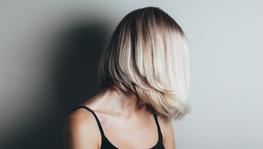Credit To: Hana Hong on realsimple.com
We all learn how to wash our hair around the same time we learn the ABCs, but unlike the alphabet, it turns out that the everyday ritual isn’t that elementary. Even the little things in your sudsing process can have big consequences for your scalp and hair (see: hair loss and dandruff), and taking into account the types of shampoos, temperature of the water, and your washing schedule (did we mention co-washing?), doing it right can be a real headache. But, like anything, there is always room for improvement, and it’s fairly easy to do that—once you know you’re making mistakes, that is. With that in mind, we asked hairstylists (aka the people professionally trained in the art of shampooing) what the most common hair-washing mistakes are so that we don’t make them.
1 You shampoo too often, or not enough.
Ah, the age-old debate of how often to wash your hair. Not washing often can leave your scalp itchy and irritated, but washing too often can leave your scalp dry and producing more oil to compensate.
Although we wish there was a universal number we could give you, experts say that the frequency of shampooing hair is reliant on a variety of things, including both hair texture and lifestyle. “If you have fine, oily hair, I would suggest washing every other day. This is also the best practice for people with dandruff,” says Paul Wintner, professional hairstylist and educator for Alterna Haircare. “For people with a normal to dry scalp, or curly/coily hair, you should stretch out your wash days to one or two times a week maximum.” Regardless of hair type, try to avoid washing every day if possible.
2 You OD on dry shampoo.
Dry shampoo is a godsend for greasy, second-day hair, but overusing it can cause buildup, leaving the strands limp and clogging the hair follicles on the scalp. “I usually suggest only using dry shampoo one to two times between washes,” says Wintner. If you want to reset your style to extend time between wash days, he recommends Alterna Meltaway No Rinse Micellar Cleanser ($29; ulta.com), a no-rinse cleanser that uses micellar technology to trap oil and sweat from the hair, allowing you to easily brush it away.
RELATED: How Much Dry Shampoo Is Too Much?
3 You’re not completely wetting your hair first.
It’s easy to get impatient in the shower (especially if you’re a chronic alarm snoozer), but truth is that every strand needs to be soaking wet in order to get a deep clean. “Not doing so will make it more difficult to spread the product through your hair and cause you to overuse shampoo,” says Wintner. Make sure your hair is completely wet in order to allow the shampoo to emulsify.
4 You massage too hard.
We all love a vigorous head scrub at the salon, but don’t do it every day at home. Wintner says massaging too hard can cause breakage (read: hair loss) and even scratches on the scalp that lead to scarring. “The best practice is to use the pads of your fingertips and not your fingernails to scrub your scalp. Using circular motions with slight pressure will be enough to cleanse the scalp and hair,” he says.
5 You’re shampooing the ends.
Focus on the roots, not the ends. Intentionally emulsifying the ends can cause unwanted tangling and knots. Lather and massage the roots to mid lengths, then let the water naturally drive the soap down when you rinse.
6 You’re not shampooing long enough.
Fast and furious is a great tagline, but not a great motto for washing your hair. If you’re in and out of the shower in five minutes, you’re probably not doing it right. “It’s important to take enough time to scrub and massage the scalp well,” says professional hairstylist Gina Rivera. “This is important because massaging generates blood flow, which contributes to a healthy scalp. A healthy scalp makes for healthy hair.” (Not thoroughly cleansing clogged hair follicles can also lead to hair loss if not careful.) Wintner says a good practice is to shampoo with circular motions all over your scalp for two to three minutes.
7 You use the same shampoo year-round.
While it’s a beauty myth that your hair gets used to the same shampoo over time, you still want to switch things up occasionally. Your hair needs can shift with the changing seasons, styling habits, and coloring. For example, a smoothing shampoo might come in handy in the humid summer months, while a volumizing shampoo is probably better for the drier winter season. Wintner recommends switching off between a clarifying shampoo and moisturizing shampoo to reduce buildup, and of course, a color-treated shampoo if your hair is dyed.
Now that we know what not to do, see below for a stylist-approved, step-by-step tutorial for how to wash and condition your hair.
How to Wash Hair
Related Items
1 Soak hair with warm water before shampooing.
Water is the first step of loosening up oil, dirt, and product buildup on your hair. Water is also vital for getting a rich lather, notes Lorean Cairns, co-founder and creative director of Fox & Jane. “Most shampoos are similar to a concentrate, so water helps dilute it so you’re able to easily spread it across the scalp.” Use warm water at this step to open up the cuticle.
2 Start shampooing at the roots.
Wintner suggests using a dime to quarter-sized amount, depending on hair length and density, and only adding more if needed. Since oil is produced at the scalp, you want to make sure you suds up there first. Start at the hairline and massage back towards your ends.
3 Scrub your scalp—not your hair.
A vigorous scrub is great for scalp health but can be too much for strands. You don’t want to rough up the cuticle, so try to gently “massage” the shampoo into your stands, not “scrunch” it.
4 Rinse and repeat if necessary.
If it’s been a while since you last washed your hair, the first shampoo application might not be as effective. Do it twice if you started with very greasy or product-laden hair. A good indicator of it’s still dirty after the first shampoo is if it doesn’t produce a robust lather.
5 Rinse shampoo thoroughly.
Your conditioner won’t be able to do its job if you have leftover shampoo lying around. Rinse thoroughly for at least three minutes—focusing on the back of the head and nape of the neck—to make sure all residue is gone. Cairns also advises wringing out hair thoroughly before applying conditioner so as to not dilute it.
6 Apply conditioner on bottom half of hair.
No matter your hair type or texture, keeping conditioner strictly on your ends is the best practice. After applying conditioner to your ends, use your fingers like a comb to rake the product through the length of hair. This will help evenly distribute product and remove tangles.
7 Rinse conditioner with cold water.
We all prefer warm water, but experts recommend dialing down the temperature for a final rinse. If you can stand it, rinsing out conditioner with cool water helps seal in nutrients and smooth the cuticle for shiny, smooth hair. It might not be the most comfortable, but your post-shower sheen will thank you.




